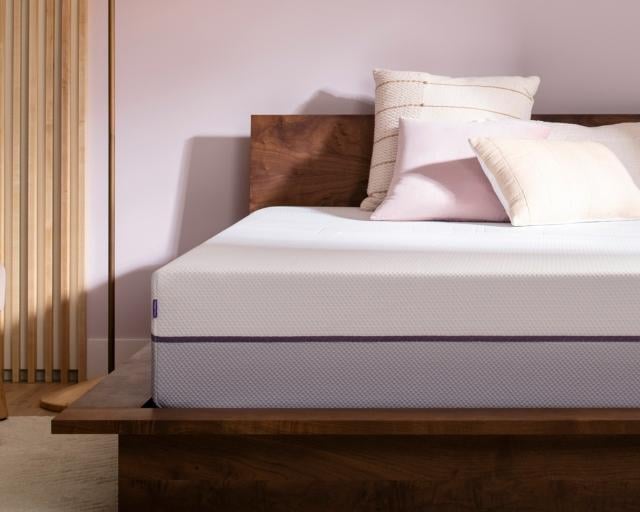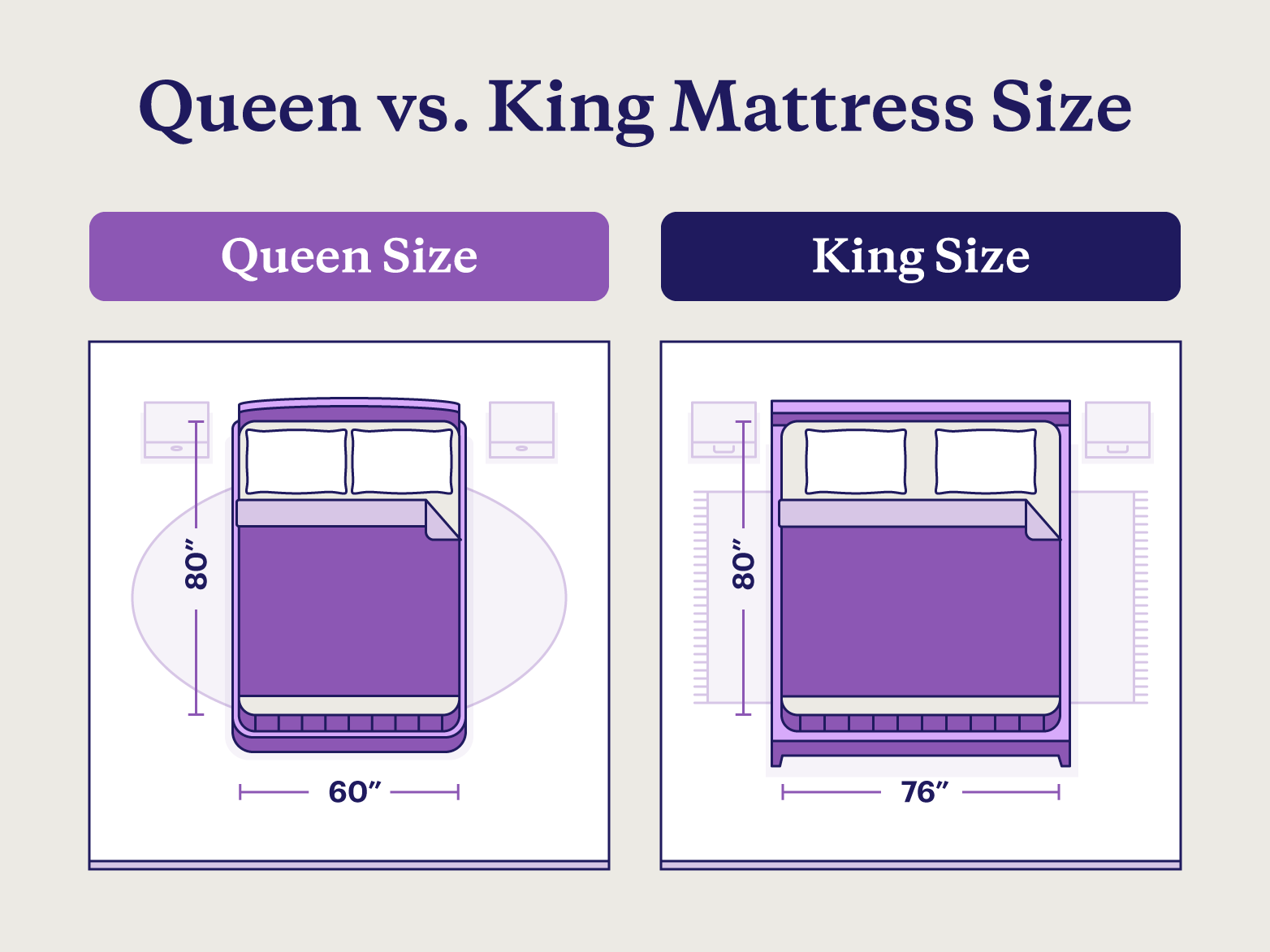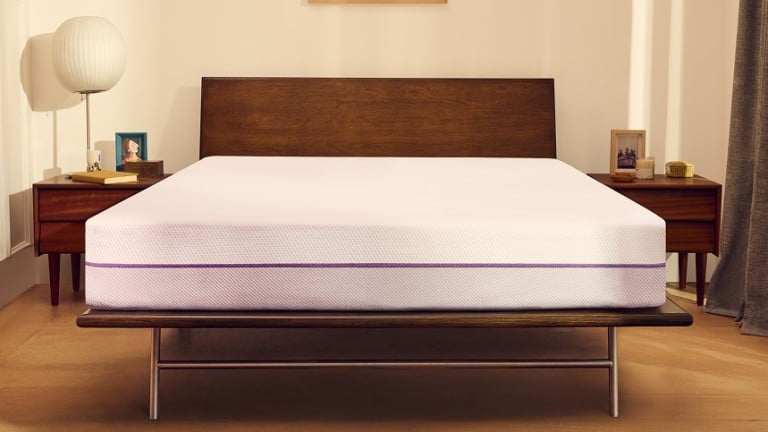King vs. Queen Bed: An In-Depth Comparison Guide + CHART
Key Takeaways
- King size beds measure 76-by-80 inches. King beds fit couples, allowing space to move freely or to co-sleep with children or pets.
- Queen beds measure 60-by-80 inches. Two adults fit well on a queen bed, but little room is available for co-sleeping with children or pets.
- To choose between a king vs. queen bed, consider your bedroom dimensions, number of sleepers, and body type.
A queen mattress is the most common bed size for adults, but a king bed may be the better solution for some sleepers.1
It’s important to know the fine details when choosing the right mattress size for you. The most apparent distinction between a king vs. queen bed comes down to a 16-inch difference in width.
In this article, we break down the key distinctions between king vs. queen size mattresses, including dimensions, recommended room sizes, and more, to help you decide between the two.
King vs. Queen Size Comparison
King size mattresses, also known as Eastern king mattresses, measure 76 inches in width and 80 inches in length. This equates to 6,080 square inches of sleeping space. If you have a large primary bedroom, a king size bed is the perfect fit.
Queen size mattresses measure 60 inches in width and 80 inches in length — totaling 4,800 square inches of sleeping space. As you can see, the only apparent difference from a king bed is 16 inches in width. Despite being a smaller variation, queen mattresses are still a good option for partners, but they're especially beneficial for individual sleepers who prefer the luxury of space.
Differences Between Queen and King Beds
There are a few key differences between a king and a queen bed. Let’s break them down in the table below.
Queen | King | |
Width | 60” | 76” |
Length | 80” | 80” |
Surface Area | 4,800 sq. in. | 6,080 sq. in. |
Room Size | 10’ x 10’ | 12’ x 12’ |
Good For | Couples and single sleepers | Couples with children and/or pets |
Price | $$ | $$$ |
King vs. Queen Pros and Cons
Queen and king mattresses each come with unique pros and cons. One primary pro of a queen size bed is that it is universally made to fit in most bedrooms, aside from a guest room tailored to a twin mattress.
Standard king beds are a staple in larger primary bedrooms. At 16 inches wider than its queen counterpart, king mattresses provide the luxury of space for those who find a queen bed too small.
In general, this generous level of comfort and space translates to higher costs, as king beds are more expensive than a queen. Here is a breakdown of the other benefits and disadvantages you need to know.
Size | Pros | Cons |
Queen | Ideal size for couples or one adult plus kids and pets Sufficient space for a single sleeper plus large pillows Fits well in a standard size bedroom with furniture Most affordable mattress size for couples | Not appropriate for more than two adult sleepers Not wide enough for a couple plus kids or pets Too narrow for restless couples May be too short for individuals over 6 feet tall |
King | Good for small families and couples Appropriate for various body types and sleep positions Large enough to limit sleep disruptions from restless partners Makes for a luxurious bedroom aesthetic | King mattresses and accessories are pricier than queen sizes Takes up more space than a queen bed and may not fit in some bedrooms Isn't as easy to move or transfer May be too short for sleepers over 6 feet tall |
Who Is a Queen or King Bed Best For?
When determining the right mattress size, it’s important to take into account your sleeping positions, the number of sleepers, and your current and future room size.
A standard queen mattress is an excellent option for couples, two adults, or anyone who doesn’t have a huge primary bedroom to accommodate a king size mattress.
King beds, on the other hand, are the primary choice for couples where at least one partner is a restless sleeper. The extra space allows for minimal motion transfer and sleep disruptions, maintaining an optimum comfort level. Parents who sleep in the same bed as their children can also benefit from the extra width.
King and queen pillow sizes are also designed to suit their respective mattress sizes, though you can comfortably use queen size pillows on a king mattress.
How To Choose Between a Queen vs. King Bed
Since both queen and king beds are a great option for couples, there are other considerations to weigh and help you decide between a king vs. queen bed. Here is a comprehensive list of these factors to keep in mind.
1. Count the Number of Sleepers
King and queen mattresses are both designed for couples or sleeping partners. For couples who want to sleep in the same bed as their children or pets, a king will be the option that guarantees adequate space, though larger families may consider a bigger bed size like the Alaskan king for maximum comfort.
For most single sleepers, a queen bed provides adequate space while a king tends to provide more than enough room, if not too much. With a queen, you can stretch your limbs as much as you want and sleep in any position you desire, meaning a king is not necessary for comfort optimization.
2. Consider Your Body Size
Sleepers' body size and weight are critical factors in choosing the right mattress size. Couples with plus-size bodies and above-average heights tend to spring for king size beds for more room and comfort. Couples, where one or both partners have plus-size frames, may find queen mattresses to be tight sleeping quarters, resulting in discomfort.
3. Consider Your Sleeping Position
You should always consider your and your partner’s sleeping positions and comfort preferences before buying a mattress.
Many people switch sleeping positions during the night, and some people sleep more sprawled than others. Queen beds may not be ideal for these kinds of sleepers not sleeping alone, but a king allows for a wider range of motion without disturbing the other people in the bed. The greater distance between sleepers on a king bed is also more favorable for hot sleepers.
For tall sleepers who prefer to sleep alone, a queen mattress is a good option that provides moveable space and ultimate comfort. Still, a queen can be appropriate for couples who don’t toss and turn too much at night. If you and your partner work opposite shifts and don't always sleep at the same time, you may also find that a queen bed suits your needs for sprawling space.
For those that sleep on their side and those that sleep on their stomach, take note of how much space you typically occupy through the night to confirm which size mattress is best for you.
4. Measure Your Room Size
Placing a king size bed in a smaller room can limit your furniture options as well as your ability to move around. A queen might not be suitable for apartments either, as this kind of space is often designed for full or twin mattresses.
If you want to buy a queen size bed frame and mattress, your room should be at least 10-by-10 feet, while a king bed should be placed in a room with minimum dimensions of 12-by-12 feet. This leaves generous space for you and other objects.
Apart from bedroom size, there are other variables to consider before choosing between a king vs. queen bed. You also have to consider the arrangement of your furniture, appliances, wardrobe, and other components before deciding on the ideal mattress size, as you don't want your bed to steal floor space.
5. Reflect on Your Budget
How much is your budget for a new mattress? Prices for both mattress types vary significantly depending on a number of factors. Generally, a king bed is pricier than a queen. With its bigger dimensions, elaborate materials, and accessories, this is only reasonable. Depending on when you buy a mattress, you may spend different amounts of money, but most kings will be pricier than queens.
High-quality queen beds normally cost around $1,000 to $2,500. On the other hand, king size beds of the same quality typically cost $1,500 to $3,000. In addition to this, king bed frames, foundations, and bedding will cost more.
If you're on a tight budget, a queen bed will likely be an ideal option. And if you’re looking for more affordable options outside a king vs. queen, check out Purple's wide selection of high-quality and cost-efficient mattresses.
Once you've decided on a size, you can visit a showroom or learn how to buy a mattress online without leaving home.
Purple Mattresses Fit for Royalty
Choosing between a queen vs. king bed is all about individual preferences. If you’re considering replacing or upgrading your mattress, Purple has your back — literally.
Whether your space better fits a queen bed or you’d like the extra sleeping space with a king, Purple has a mattress for you. Our proprietary GelFlex® Grid provides adaptive support that cradles your body’s curves, offering ultimate pressure relief, motion responsiveness, and impeccable breathability.
FAQ about King vs. Queen Beds
King mattresses are 16 inches wider than queen beds. The width of a king bed equals 76 inches whereas a queen bed is 60 inches wide.
Queen beds are not bigger than a king. Although both sizes measure 80 inches in length, their widths vary. King beds offer nearly 9 square feet more sleeping space.
The difference between a king and a California king is their dimensions. A king mattress measures 76 inches in width by 80 inches in length. On the other hand, a California king mattress has dimensions of 72 inches in width by 84 inches in length. The king size bed is the standard mattress variation.
Queen beds are the more popular mattress size for couples and single adult sleepers. This tends to be because of their lower price point and limited bedroom space.
Both queens and kings make a great bed size for couples. The queen mattress is a favored option for couples of average body types, while the king mattress is ideal for plus-sized and taller couples or those with children.
While king mattress sizes aren’t ideal for everyone, there are a few reasons why a king bed is worth its cost. A king bed gives you and your partner more sprawling space, providing unmatched coziness and quality sleep. The extra room helps limit motion transfer between sleepers, as well.
Both king and queen beds have their fair share of benefits and, certainly, some drawbacks. When it comes to which option is better, it really depends on what suits your personal necessities.
That said, the choice is yours. If you have a king and feel like you have too much space, you might even consider downsizing to a queen or full bed. Consider your preferences and the factors we discussed in this guide — like number of sleepers, room size, and budget — to make the right decision!
Two twins do not make a king or queen. Standard twin mattresses are 5 inches too short to make a proper king bed. Two twin XLs make a split king.
More To Explore
Level up your sleep routine with our most-loved products.










